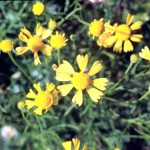Western Bitterweed, Bitter Rubberweed
Hymenoxys odorata DC.
Asteraceae (Sunflower Family)
Description
Western Bitterweed is an erect, annual, composite plant in the Sunflower family. It ranges from 3 inches to 2 feet or 7 to 61 cm tall. The stems are purplish near the base. This plant has a bitter taste and a distinct odor. Maximum plant growth occurs during the spring and early summer seasons. Depending on available moisture, seedlings can be seen throughout the year. The leaves are simple, typically woolly underneath, and are located alternately along the stems. Bright yellow flowers bloom from April through June and occasionally in the fall. Blooming may begin as early as February and as late as August. The ray flowers are 3-lobed. Both the ray and disk flowers are yellow. With adequate rainfall, it is common to see pastures turn yellow from this plant in the spring. The seeds have pappus (hairs) that aid in dispersion by wind. Western Bitterweed is highly toxic to sheep, especially during drought.Habitat
Bitterweed is common in arid and semi-arid areas of the southern Great Plains from southwestern Kansas and central Texas to southern California and into Mexico. It is most common where soil disturbance or overgrazing has occurred. The populations can vary considerably from year to year. Habitat types include roadsides, drainage areas, streambanks, open sites, pasturelands, and bottomlands.Toxic Agent
Western Bitterweed mainly causes issues for sheep, but cattle are occasionally poisoned. The toxins are several sesquiterpene lactones, and the plant’s toxicity increases with maturity. The toxins are found in all parts of the plant with new growth having the highest concentrations. Bitterweed is an irritant to the digestive tract. Since it has a bitter taste and is unpalatable, it is generally avoided by livestock unless there is a shortage of other forage. Tolerance to Bitterweed consumption depends on various factors. If large amounts are consumed quickly, then acute poisonings can result in death, but it is not common under normal conditions. Chronic poisoning is common in sheep where they develop a wasting disease. Under normal grazing conditions, signs of ingestion and poisoning occur within 2 to 4 weeks after livestock begin consuming Bitterweed. Individuals may recover if access is removed from the plant at the first signs of ingestion. If around 1% of the individual’s body weight is consumed, it can be lethal.Signs of Livestock Ingestion
Signs of ingestion include: Loss of Appetite/Weight, Depression/Weakness, Irregular or Stiff Gait, Vomiting and Coughing, Death, Elevated Head, Bloating, Congestion, Inflammation and Hemorrhage of the Digestive Tract, and Lagging behind the herd.Management Strategies
There is no treatment for individuals poisoned by consuming Bitterweed. Individuals that are not severely poisoned may be removed from pastures containing the plant and may recover if given good feed and water over a few days. Landowners with infested pastures should be aware of what their sheep are consuming, especially during the winter and spring months as well as during a drought. Observations of the flock or herd should be made regularly to catch early signs of poisoning. According to the USDA-ARS (Agricultural Research Service), seasonal control can be obtained by use of 2, 4-D (1 lb ae/acre), picloram (0.5 lb ai/acre), clopyralid (0.25 lb ai/acre), or metsulfuron (1.25 oz product/acre). This control method should be applied from autumn to early spring before the plant flowers and when it is actively growing. Poisoning may also be prevented by using moderate stocking rates over a deferred rotational grazing system or a light stocking rate of a continuous grazing system with sheep, cattle, and goats.Images
Plant Characteristics
Flower Color: Yellow
Seed Type: Non-Encapsulated
Duration: Annual
Stem Texture: Hairless/Smooth
Growth Habit: Forbs/Broadleaf
Leaf Shape
 : Simple with Pinnate or Parallel Venation
: Simple with Pinnate or Parallel Venation
Season: Warm
Distribution
 : 04 - Blackland Prairies, 05 - Cross Timbers and Prairies, 06 - South Texas Plains, 07 - Edwards Plateau, 08 - Rolling Plains, 09 - High Plains, 10 - Trans-Pecos
: 04 - Blackland Prairies, 05 - Cross Timbers and Prairies, 06 - South Texas Plains, 07 - Edwards Plateau, 08 - Rolling Plains, 09 - High Plains, 10 - Trans-Pecos
Distributions
Distribution refers to the ecological region in Texas that a plant has been found. You can also view a clickable map.
Book: Brush and Weeds of Texas Rangelands (B-6208), Toxic Plants of Texas (B-6105)
Collection: Brush and Weeds, Toxics, Wild Flowers
Livestock Affected: Cattle, Sheep
Livestock Signs: Abdominal Pain, Anorexia, Arched Back, Bloat and Pulmonary Congestion, Colic, Depression/ Weakness, Elevated Head, Inflammation/Hemorrhage of Digestive Tract, Loss Of Weight, Stiffness, Vomiting/Regurgitation





